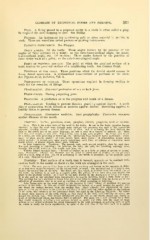Page 453 - My FlipBook
P. 453
GLOSSARY OF TECHNICAL TERMS AND PHRASES. 301
Plug. A filling placed in a prepared cavity in a tooth is often called a plug.
In England the word stopping is used. See Filling.
Plxjgger. An instrument for condensing gold or other material in cavities in
teeth. These are sometimes called packers or packing instruments.
Plugging instruments. See Plugger.
Point angles. Of the teeth: Those angles formed by the junction of the
angles of three surfaces at a point; as the disto-bucco-occlusal angle, the mesio-
bucco-ocelusal angle, etc. Of cavities: Those angles formed by the junction of
three cavity "walls at a point; as the axio-buceo-gingival angle.
Point of proximal contact. The point at which the proximal surface of a
tooth touches the proximal surface of a neighboring tooth. See Contact Point.
Positions at the chair. Those positions which the dentist should assume in
doing dental operations. A systematized nomenclature of positions at the chair.
See Figures 34-45, inclusive, Vol. 2.
Preparation of cavities. Those operations required in forming cavities in
teeth for the reception of fillings.
Prognathism. Abnormal protrusion of one or both jaws.
Prognathous. Having projecting jaws.
Prognosis. A prediction as to the progress and result of a disease.
Prophylactic. Tending to prevent disease; guarding against disease. A medi-
cine or preparation which defends or protects against disease. Something applied to
healthy tissue to prevent disease.
Prophylaxis. Preventive medicine. Oral prophylaxis: Preventive measures
against diseases of the mouth.
Proximal. Latin; proximus, near; propior, nearer; propious, next or nearest.
Note. This is the oldest form of the word in the Latin. In use in the Latin, proprius became
obsolete ; in time the word went through many changes and proximus was used as the superlative
adjective, meaning nearest — next in line before or after. But in following the word through the
time of the active use of the Latin language, we find it used in a variety of subjects, as: Time,
next day, next month, or next year. Relationship, next of kin, next neighbor. Of things, next house.
Of a series, the next preceding or following, etc. Quotations from Harpers' Latin Dictionary. Proxi-
mus: of place, nearer, nigher ; of time, nearer, later, more recent; of relationship, nearer, more
nearly related; of resemblance, more nearly resembling, more like; of relation or connection, more
nearly related, of greater import, closer, more intimate.
In later composition. Proximus: The nearest, next, one's nearest neighbor, close by, next door.
The next preceding or following ; the previous, the last ; the next, the following, ensuing ; time,
recently, last of all, next day, next month, next year, etc.
Webster defines proximal thus: " Toward or nearest, as to a body or center of motion or depend-
ence. Proximate. {Biol.) (a) Situated near the point of attachment or origin; as the proximal
part of a limb, twig or leaf, (b) Of or pertaining to that which is proximal ; as the proximal bones
of a limb. Opposed to distal."
Dentistry: That surface of a tooth that is toward, nearest, or in contact with
another tooth to the mesial or distal as the teeth are arranged in the arch.
Note. The word proximal has been much used in anatomy and botany as the opposite of distal,
or as next to a thing understood The proximal end of a bone is that
; as the central body, or trunk.
nearest the central line of the body. The distal end, that which is farthest from the central line of
the body. In botany, it is used in a similar sense, the portion of the limb of a tree nearest the
trunk is the proximal portion. It is used in the same manner in the description of twigs and leaves.
It is also used in the adverbial form (proximally) to express direction along a limb, twig or leaf.
This meaning has been acquired in recent time and is not quite in harmony with the Latin use of the
adjectives of proximare, near to or next to anything or object preceding or following.
John Tomes gave us the word mesial as the opposite to distal instead of proximal for naming
surfaces of the teeth. In this use, mesial designates the surface of a tooth toward the median line,
and distal the surface farthest from the median line. Much difficulty was experienced by many
persons in the use of these words until the definition of their meaning, when applied to the surfaces
of the teeth, was extended by the additional words italicized in the following definition. By mesial
is meant those surfaces of the teeth which, as they stand in the arch, and following its curve, are
toward the median line. This seemed satisfactory and the use of the words, mesial and distal, in
place of proximal and distal, has become fully established. But there was a real necessity for a word
that would designate collectively the surfaces denned as mesial and distal and the usage of many
persons in the dental profession has clung tenaciously to the term proximal, as meaning next, or next
to, which is really its Latin signification, in spite of the fact that it has been used in a special


